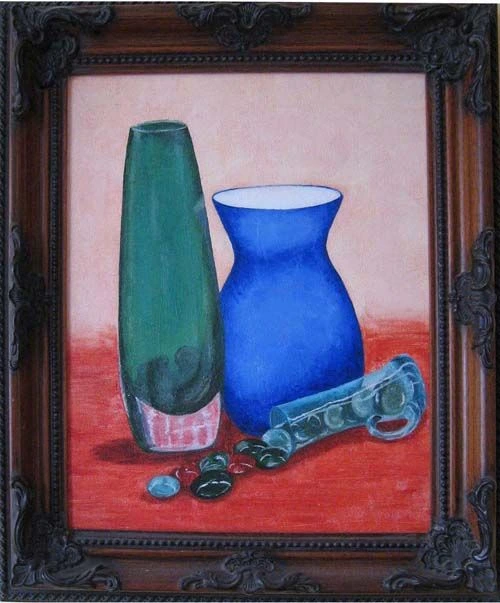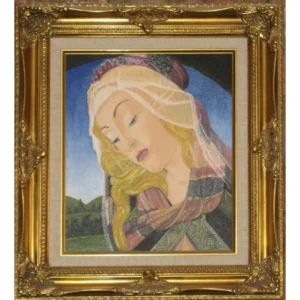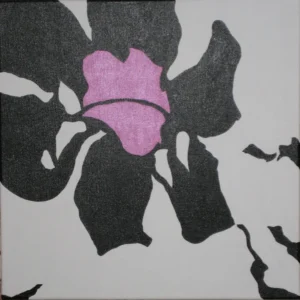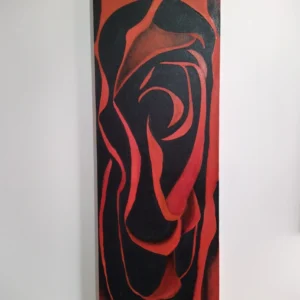3 Vases-1
A Journey Through Form, Colour, and Texture, 3 Vases-1
3 Vases-1 art, in its purest form, captures the essence of life through brushstrokes, colours, and texture. For the artist Lynne Potrykus, her work is an exploration of both the physical and emotional realms, allowing the viewer to experience something deeply personal yet universally resonant. One of her most captivating pieces, titled 3 Vases-1, is a prime example of this profound artistic journey. Painted on artist’s board using oil paints, 3 Vases-1, is not just a still life, it’s a study in the delicate interplay between glass, light, and space, encapsulating the fragility of human experience.
The Power of Three Vases. A Study in Glass and Light
In 3 Vases-1, the viewer is confronted with three distinct glass vessels, each rendered with meticulous detail and care. However, these vases are more than mere objects, they represent a dialogue between transparency, opacity, and imperfection. The first vase is entirely transparent, its crystalline surface allowing light to pass through and reflect in a dazzling play of highlights and shadows. This vase represents clarity, purity, and openness, qualities that are often revered yet elusive in both art and life.
The second vase is semi-transparent, a delicate interplay between opacity and transparency. The soft light that filters through it seems to be slightly muted, suggesting the complexity of human emotion or the way experiences can obscure clarity. The semi-transparent vase stands as a metaphor for those moments when things are not entirely clear, but we can still discern traces of what lies within. This vase symbolises the nuances and in-betweens that colour our existence, those Gray areas where certainty is replaced with ambiguity.
The third vase, opaque and solid, stands as a counterpoint to the other two. Its surface is impervious to light, with no reflections or transparency to reveal its contents. Yet, in its darkness, there is something profoundly solid and grounded. This vase embodies the hidden, the secret, and perhaps the protective barriers we construct to shield ourselves from the outside world. It speaks to the inner strength required to remain whole, even when the exterior shows no signs of vulnerability.
In this juxtaposition of 3 Vases-1, Potrykus is able to evoke a range of emotions and themes, from transparency and vulnerability to opacity and secrecy. The vases are both literal and metaphorical, inviting the viewer to reflect on the varying degrees of openness in their own lives. The careful choice of these three forms is a testament to Potrykus’ deep understanding of the human condition and her ability to translate this understanding onto the canvas.
A Story of Imperfection. The Fallen Vase
As with all great works of art, 3 Vases-1, is not just about the perfect, the pristine, or the idealized. One of the vases in the painting has toppled over, spilling a scattering of glass beads onto the surface beneath. This subtle detail, far from detracting from the work, adds a layer of complexity and intrigue. It is a nod to the imperfection inherent in all things, a reminder that even the most carefully crafted vessels can falter.
The fallen vase and the scattered beads suggest fragility and the inevitable disruption of order. The beads, so delicate and small, form a random pattern across the surface, as though they are caught in the moment before they come to rest. This addition, an act of deliberate imperfection, is a quintessential example of Potrykus’ thoughtful approach to composition. By leaving this unexpected event intact, the artist breathes life into the piece, making it more dynamic, more real, and more relatable. After all, life is not a carefully arranged still life, but a series of unpredictable moments that are sometimes fragile and fleeting.
Potrykus’ decision to leave the toppled vase in place underscores her belief that imperfections can often make a work of art more interesting, more layered, and more engaging. It’s a recognition that beauty is not just about what is unblemished, but about the story told by the marks of time, the scars that remain, and the traces of past events.
The Artist’s First Oil Painting. A Moment of Discovery
3 Vases-1 holds special significance for Potrykus, as it was the first oil painting she ever created. Potrykus, who is predominantly known for her acrylic work, ventured into the world of oil painting with this piece. For many artists, switching from acrylic to oil is a major shift in both technique and mindset. Oils offer a different viscosity, a slower drying time, and a much deeper range of colour and texture. It’s a medium that encourages exploration and experimentation, and for Potrykus, it was a moment of rediscovery, a chance to bring her vision to life in a new and expansive way.
Prior to 3 Vases-1, Potrykus had spent years honing her skills with acrylics, a fast-drying medium that demands precision and quick decision-making. But oils, with their slow-drying nature, offered her a new set of possibilities. They allowed her to work in layers, build up texture, and create a depth of colour that acrylics often cannot match. In many ways, 3 Vases-1, marks a turning point in her artistic development. It is a reflection of her willingness to step out of her comfort zone and embrace new challenges.
Following this first venture into oils, Potrykus would go on to create “Madonna’s Purity”, her second oil painting, which also reflects her evolving mastery of the medium. However, 3 Vases-1, remains a milestone for the artist, an embodiment of her experimentation and her ability to bring together her knowledge of form and colour in a new way.
The Water-Based Oil Paints, A New Direction
While 3 Vases-1 stands as a testament to Potrykus’ early exploration of oils, it is far from the end of her journey with this medium. After experimenting with traditional oil paints, Potrykus stumbled upon a new type of paint, water-based oils. These paints dry much more quickly than traditional oils, offering a faster process without sacrificing the depth and richness of the medium.
Potrykus’ use of water-based oils in her later works, such as Svelte Red Rose3, represents another evolution in her artistic practice. These paints offered her the ability to work with greater speed and precision while still allowing her to maintain the fluidity and depth that oils are known for. The transition to water-based oils also brought with it a different kind of freedom, the freedom to experiment more boldly and to create more complex works in a shorter time frame.
Despite her foray into this newer medium, Potrykus continues to return to oils in various forms, using them as a tool to communicate her artistic vision with both delicacy and depth. The introduction of water-based oils, however, allows her to blend the best of both worlds, the expressive, lush textures of traditional oils combined with the quick-drying convenience of acrylics. This fusion of techniques is a hallmark of Potrykus’ artistic journey, an ongoing exploration of how materials, methods, and creativity can come together to form something unique.
The Framing. A Touch of Elegance
Every artwork tells a story, but how it is presented can significantly enhance the narrative. For 3 Vases-1, Potrykus chose to frame the piece in an ornate, dark oak frame. This framing choice elevates the painting, adding a sense of formality and gravitas. The rich, dark hue of the frame contrasts beautifully with the delicate transparency of the vases, drawing attention to the central elements of the painting while providing a balanced backdrop that enhances the visual impact.
The frame, like the painting itself, is a reflection of Potrykus’ careful attention to detail. It is not just an afterthought but a vital part of the overall composition. The dark oak wood serves to ground the painting, providing a subtle contrast to the lightness of the vases and creating a sense of harmony between the artwork and its environment. When viewed in person, the framed 3 Vases-1, takes on a presence that invites the viewer to step closer, to engage more deeply with the work.
The Legacy of Vases in Art
The motif of vases has long been a favourite among artists, from the ancient Greeks to contemporary masters. The vase, whether it is depicted in crystal, porcelain, or glass, carries with it a long history of symbolic meaning. In classical art, vases often served as containers for beauty, whether in the form of flowers, fruits, or other natural elements. They symbolize both the fragility and the enduring nature of beauty, as well as the transience of life itself.
One of the most famous examples of vases in art is Édouard Manet’s “Flowers in a Crystal Vase”, painted in 1882. Like Potrykus’ 3 Vases-1, Manet’s work explores the delicate balance between form, transparency, and reflection. While Manet’s vase is filled with a vibrant display of flowers, Potrykus’ vases are empty or incomplete, highlighting the intrinsic beauty of the vessels themselves rather than their contents. This subtle yet powerful distinction allows 3 Vases-1, to stand apart as a unique contribution to the long tradition of vase depictions in art.
In many ways, 3 Vases-1, continues this legacy, but with a modern twist. Potrykus’ use of glass as the primary material creates a sense of transparency and lightness that reflects the evolving sensibilities of contemporary art. Yet, it also calls back to the classical tradition, grounding the work in a rich history of symbolism and meaning.
Conclusion. The Art of Subtlety and Reflection
At its core, 3 Vases-1, is a painting about observation, the act of looking closely, of seeing not just the surface of things but their deeper significance. In the three vases, each distinct in its transparency, opacity, and fragility, Potrykus invites the viewer to reflect on their own relationship to transparency, vulnerability, and strength. The toppled vase, spilling its contents, reminds us that life is unpredictable and often imperfect, but it is this very imperfection that gives life its richness.
Through 3 Vases-1, Potrykus has created a work that is not just a study in glass and light, but a meditation on the human experience. It’s a celebration of both the beautiful and the broken, a reminder that even in the most fragile of forms, there is beauty to be found. In the delicate balance between form and imperfection, Potrykus has captured something timeless, a reflection on the delicate interplay between light, space, and life itself.
Commission a Custom Art Piece
You can commission a bespoke artwork in your choice of colour (subject to availability), adding a personal touch that reflects your unique story and experiences. Each piece is thoughtfully crafted, ensuring that no two are ever the same, just like the moments they capture. This process fosters a meaningful connection between artist and patron, celebrating the individuality of each person’s journey through time.
Commissions Form
The more detail you provide, the better we can tailor the piece to your vision. Commissions typically take between 2 to 6 weeks to complete.
Thank you for looking
Please note, colours may vary from monitor to monitor.
Check out my other works here at https://lyn-5818.canvy.art/






Reviews
There are no reviews yet.